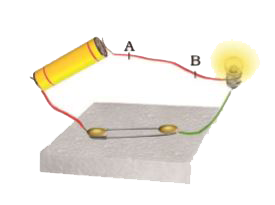The maximum current that flows through a fuse wire before it blows out varies with its radius as
r3/2
r
r2/3
r1/2
The correct Answer is:A
To determine the relationship between the maximum current (I_max) that flows through a fuse wire and its radius (R), we can follow these steps:
1. Understanding the Problem:
- We need to find how the maximum current (I_max) relates to the radius (R) of the fuse wire.
- The fuse wire is a thin wire that melts when the current exceeds a certain limit, which is what we are trying to express mathematically.
2. Heat Generation in the Wire:
- The heat generated in the wire due to the current can be expressed using Joule's law:
Q=I2R
- Here, Q is the heat produced, I is the current, and R is the resistance of the wire.
3. Resistance of the Wire:
- The resistance R of the wire can be expressed as:
R=ρLA
- Where ρ is the resistivity of the material, L is the length of the wire, and A is the cross-sectional area. For a wire with radius R, the area A is:
A=πR2
- Thus, we can rewrite the resistance as:
R=ρLπR2
4. Heat Balance at Maximum Current:
- At the maximum current (I_max), the heat generated equals the rate of heat loss. Assuming steady-state conditions, we can write:
I2maxR=Q⋅A
- Substituting the expression for resistance:
I2max(ρLπR2)=Q⋅(πR2)
5. Rearranging the Equation:
- Rearranging gives:
I2max=Q⋅πR2⋅πR2ρL
- This simplifies to:
I2max=Q⋅π2R4ρL
6. Finding the Relationship:
- Taking the square root of both sides gives:
Imax=√Q⋅π2R4ρL
- This shows that:
Imax∝R2
- However, considering the dependence on the radius more closely, we can express it as:
Imax∝R3/2
Final Result:
Thus, the maximum current that flows through a fuse wire before it blows out varies with its radius as:
Imax∝R3/2
- We need to find how the maximum current (I_max) relates to the radius (R) of the fuse wire.
- The fuse wire is a thin wire that melts when the current exceeds a certain limit, which is what we are trying to express mathematically.
- The heat generated in the wire due to the current can be expressed using Joule's law:
Q=I2R
- Here, Q is the heat produced, I is the current, and R is the resistance of the wire.
- The resistance R of the wire can be expressed as:
R=ρLA
- Where ρ is the resistivity of the material, L is the length of the wire, and A is the cross-sectional area. For a wire with radius R, the area A is:
A=πR2
- Thus, we can rewrite the resistance as:
R=ρLπR2
- At the maximum current (I_max), the heat generated equals the rate of heat loss. Assuming steady-state conditions, we can write:
I2maxR=Q⋅A
- Substituting the expression for resistance:
I2max(ρLπR2)=Q⋅(πR2)
- Rearranging gives:
I2max=Q⋅πR2⋅πR2ρL
- This simplifies to:
I2max=Q⋅π2R4ρL
- Taking the square root of both sides gives:
Imax=√Q⋅π2R4ρL
- This shows that:
Imax∝R2
- However, considering the dependence on the radius more closely, we can express it as:
Imax∝R3/2
Thus, the maximum current that flows through a fuse wire before it blows out varies with its radius as:
Imax∝R3/2
Topper's Solved these Questions
- THERMAL AND ELECTRIC EFFECT oF CURRENTBOOK - CP SINGHCHAPTER - THERMAL AND ELECTRIC EFFECT oF CURRENTEXERCISE - Exercises
101 Videos
- SEMICONDUCTORSBOOK - CP SINGHCHAPTER - SEMICONDUCTORSEXERCISE - Exercises
140 Videos
- WAVE NATURE OF LIGHTBOOK - CP SINGHCHAPTER - WAVE NATURE OF LIGHTEXERCISE - EXERCISES
140 Videos
Similar Questions
Knowledge Check
When a current flows through a conductor its temperature
AMay increase or decreaseBRemains sameCDecreasesDIncreasesIn a wire of cross-section radius r, free electrons travel with drift velocity v when a current I flows through the wire. What is the current in another wire of half the radius and of the same material when the drift velocity is 2v?
A2IBICI/2DI/4A time wire with a circuit-sectional radius of 0.02mm blows with a current of 5 ampere for what current another fuse wire made from the same material with cross-section radius of 0.04 mm will blow?
A14.7AB5AC3AD1.5A
If a current of 3 A flows through a wire of resistance 8 ohms, calculate the potential difference applied across its ends.
View SolutionIf a current of 0.5A flows through a metallic wire for 2 hours, then how many electrons would flow through the wire ?
View SolutionIf a current of 0.5A flows through a metallic wire for 2 hours, then how many electrons would flow through the wire ?
View SolutionIf a current of 0.5 ampere flows through a metallic wire for 2 hours, then how many electrons would flow through the wire?
View SolutionIf a current of 0.5 ampere flows through a metallic wire for 2 hours, then how many electrons would flow through the wire ?
View Solution

